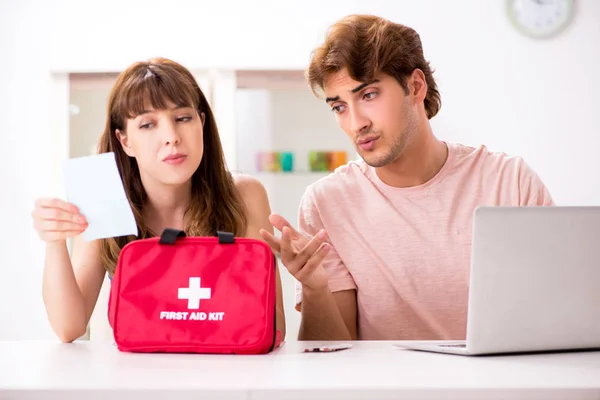In our daily lives, accidents and injuries can occur unexpectedly. Whether at home or during our travels, having a well-stocked first aid kit can make a significant difference in addressing minor injuries and providing initial care until professional medical help is available. Building a first aid kit is essential in preparing for medical emergencies.
This comprehensive guide will walk you through the thing should know when preparing to build a kit. By being proactive and assembling a well-equipped first aid kit, you can ensure the safety and well-being of yourself and your loved ones in times of need.
Basic Supplies
Certain essential supplies should always be included when building a first aid kit for home and travel. These supplies serve as the foundation of your kit and enable you to address a wide range of injuries and emergencies.
Start by stocking up on adhesive bandages in various sizes to cover cuts and wounds. Sterile gauze pads and adhesive tape are vital for dressing larger wounds. Antiseptic wipes or solution help prevent infections, while tweezers and scissors assist in wound cleaning and cutting bandages.
Disposable gloves ensure personal protection, and a CPR mask or face shield is crucial for emergency resuscitation. Remember to include a thermometer, safety pins, splint, and elastic bandage for added versatility.
Consider the Purpose
It’s essential to consider your kit’s specific purposes, whether it’s for home use or travel to different environments or activities. Tailoring your kit to meet these specific needs can enhance its effectiveness.
For home use, focus on addressing common injuries and illnesses. Include over-the-counter medications like pain relievers such as acetaminophen or ibuprofen, antihistamines for allergic reactions, and antacids for indigestion or heartburn.
Furthermore, include items like anti-diarrhea medication, hydrocortisone cream for itching or rashes, and calamine lotion for insect bites or stings.
Consider additional supplies for travel, especially to remote areas or outdoor activities. Include blister pads, moleskin for foot blisters, a snake bite kit, and water purification tablets.
If you’re traveling to a sunny destination, remember to pack sunscreen and insect repellent suitable for the region. These extras can address specific challenges you may encounter while away from home.
Storage and Maintenance
Proper storage and regular first aid kit maintenance are crucial to ensure its effectiveness and longevity. To keep your kit in optimal condition, you should first choose a durable, waterproof container that can protect the contents from moisture and damage.
Consider using a portable bag or box with compartments for easy organization. Store the kit in a cool, dry place that is easily accessible. Avoid exposing it to extreme temperatures or direct sunlight, as this can affect the integrity of medications and supplies.
Regularly check the expiration dates of items in your kit and promptly replace any that have expired. Keep a checklist of essential items and periodically review and restock the kit as needed.
Additionally, consider specific needs within your household or travel group. If anyone requires specific medications or has unique medical conditions, make sure their requirements are accounted for and kept up to date in the kit.
By taking these storage and maintenance steps, you can ensure that your first aid kit is ready for use whenever emergencies arise, providing peace of mind for both home and travel situations.
Personal Prescription Medications
If any individuals in your household or travel group require specific medications for their medical conditions, ensure they are included in the kit. Make a list of necessary prescription medications and regularly check their availability and expiration dates. Keep in mind the duration of your travel and pack an adequate supply of each medication to last throughout the trip.
It’s recommended to store prescription medications in their original labeled containers to make sure everything is clear. Consult with healthcare professionals to obtain additional copies of prescriptions or special instructions if needed.
When you include a personal prescription medications in your first aid kit, you can ensure that individuals with specific medical needs have access to their required treatments, providing them with necessary care and peace of mind while away from home.
Regularly Update and Replenish Your Kit
Creating a kit is not a one-time task. To ensure its effectiveness, it’s crucial to update and replenish your first aid kit regularly. By doing so, you can maintain the kit’s readiness and ensure that you have the necessary supplies to address unexpected situations. Here are the reasons why regular updates and replenishment are essential:
- Expiration Dates: Many items in a first aid kit, such as medications and ointments, have expiration dates. Over time, these products can lose their potency and effectiveness. Regularly checking and replacing expired items is vital to ensure that your kit contains fresh and reliable supplies. This way, you can trust that your first aid kit will deliver the intended results when needed.
- Depleted Supplies: During emergencies or minor incidents, you may need to use certain supplies from your first aid kit. It’s important to replenish these items promptly to maintain the kit’s readiness. Whether it’s adhesive bandages, gauze pads, or antiseptic wipes, keeping an adequate supply of these essentials ensures that you’re prepared for future situations.
- Evolving Needs: The needs of your household or travel group may change over time. Children grow, medical conditions may arise, and activities or destinations may vary. Regularly assessing your first aid kit allows you to align it with the current needs and circumstances of your family or travel companions. Adjust the kit by adding or removing items accordingly to ensure it remains relevant and effective.
Get Prepared Today!
Building a well-prepared first aid kit for home and travel is crucial in being proactive and ready to handle medical emergencies. By including the basic supplies, considering the purpose of the kit, properly storing and maintaining it, and including personal prescription medications, you can ensure that you are equipped to handle a wide range of situations.
A well-stocked and properly maintained first aid kit provides peace of mind, knowing you have the necessary tools and medications to address common injuries and illnesses. Remember to periodically review and restock your kit, check expiration dates, and tailor it to your specific needs.
With a comprehensive first aid kit at your disposal, you can confidently handle unexpected situations and provide timely care and support for yourself, your family, or fellow travelers.








